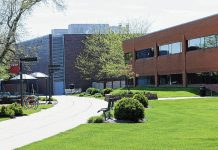In what promises to be an ambitious overlay program, crews could start laying new asphalt on rural Bartholomew County roads within a few weeks — two months earlier than usual.
The 10 miles of roads that will receive a new layer of asphalt in late March and in April were listed on Phase 2 of last year’s overlay program, county highway engineer Danny Hollander told the Bartholomew County commissioners Monday.
Due to delays in the awarding of the 2017 Next Level Roads: Community Crossings Initiative, most of the 12.5 miles listed in Phase 2 didn’t get paved before asphalt plants were forced by cold weather to close last fall, Hollander said.
Although the Community Crossings grant was announced in September, the $836,012 provided to Bartholomew County wasn’t received until January, the county highway engineer said.
With asphalt plants now reopening and the contract already awarded to Milestone Contractors, Hollander said crews are anxious to complete last year’s 10 miles before the work starts interfering with their regular spring schedule.
It will still be another month before roads are selected for Phase 1 of the new 2018 overlay program.
Starting next week, Bartholomew County Highway Superintendent Dwight Smith will begin inspecting 700-plus miles of county roads. Those inspections are expected to continue through the first week of April, Hollander said.
A few weeks later, Smith is expected to present the commissioners with a list of about 30 miles of rural roads that he believes are in most need of new blacktop, Hollander said.
Over the past five years, the county has repaved an average of about 22 miles of roads annually.
But since there have been quite a few freeze-and-thaw events this winter that have caused substantial road damage countywide, Smith might list as many as 40 miles this year, Hollander said.
“We’ve got our work cut out for us,” the highway engineer said.
Bids will likely be awarded for the 2018 overlay program in May, with work proceeding at the contractor’s discretion, Hollander said.
While that indicates a total of 50 miles — from last year’s leftover and this year’s new programs, combined — could get a new blacktop, Hollander admits that amount may not be realistic. It is more than twice the average miles of overlay during the past five years.
Although contractors handle paving, it’s still up to 15 county highway employees to prepare overlay areas by replacing questionable culverts, as well as preparing shoulders and road edges, Hollander said.
Those same workers will also have to deal with an extensive chip-and-seal program that provides five-year road repairs with a less expensive mixture of asphalt and gravel mixture, he said.
When grants and additional revenue from last year’s 10-cent-a-gallon gas tax hike now available, adequate funds for roads should be available.
But as commissioner Rick Flohr pointed out, other counties and cities are also getting a lot of money for their roads. That means more competition for a limited number of contractors, which could cause prices to escalate, both Flohr and Hollander said.
In addition, the county must soon make a substantial investment into repairing the concrete surface of the East 25th Street bridge that crosses Clifty Creek east of Petersville, commissioner Carl Lienhoop said.
“It needs major work,” Hollander said. “Probably not a whole new deck, but a lot of patching and a new concrete surface.”
While no timetable has been sent, the estimated $200,000 of repairs to the bridge probably should be done sooner than later, Lienhoop said.




